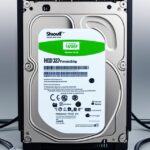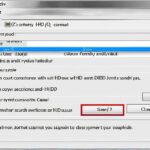Table of Contents
Learning to format an HDD in Linux is key for improving your storage. It makes sure your system can use space well. You’ll choose from several file systems like ext4, FAT32, and NTFS based on your needs12.
Knowing how to format drives in Linux helps boost your system’s performance. For example, FAT32 works with many systems but limits files to 4 GB1. NTFS fits bigger files, perfect for internal drives. Ext4 is great for huge files and works well on various platforms. Understanding these helps you organise your storage better, leading to improved system efficiency.
Key Takeaways
- Knowing the different file systems is crucial for formatting.
- Ext4, FAT32, and NTFS are used for different formatting needs.
- FAT32 is best for its wide compatibility, despite having a 4 GB file size limit.
- NTFS is optimal for large files, suitable for internal drives.
- Choosing the right file system depends on your storage requirements.
Introduction to Formatting Drives in Linux
Formatting drives in Linux is a key way to manage hard disk space well. It lets users set up partitions and choose the right file system. This meets different data storage and access needs. A format done well makes sure data is organised well. This boosts the system’s performance.
Understanding Disk Formatting
The idea of disk formatting covers both low and high-level formatting. Low-level formatting sets up the media by marking sectors. High-level formatting, on the other hand, creates a clean filesystem on each partition using tools like mkfs3. In Linux, there are several filesystems such as EXT2, EXT3, and the highly favoured EXT4. Each one is best for specific situations4.
Common Reasons for Formatting
There are many reasons for formatting HDD. Sometimes, users need to switch the file system to better suit their needs. Formatting might happen when setting up a new drive or clearing data for safety5. Addressing errors is also a common reason. For example, formatting can fix issues like the error message “ERROR FORMATTING DISK: error synchronizing after initial wipe: Timed out waiting for object (udisks-error-quark, 0)”5. Choosing the right filesystem is crucial for Linux users. It can make a big difference in performance.
Prerequisites for Formatting an HDD
Before you start formatting an HDD, some steps are crucial. Ensure your Linux system meets all requirements for a smooth process. This includes having a Linux operating system that works well with your plans. Users need the right permissions too, which means being able to use a sudo or root account.
System Requirements
To run formatting commands, a system with a modern Linux version is needed. It should meet these specifications:
| Component | Minimum Requirements | Recommended Requirements |
|---|---|---|
| Processor | 1 GHz or faster | 2 GHz or faster |
| RAM | 1 GB | 4 GB or more |
| Storage Space | 10 GB | 20 GB or more |
Don’t forget about the software needed for formatting, like GParted or Disks. These tools help a lot with partitioning and formatting5.
Getting Terminal Access
Get access to the terminal, a crucial step in HDD formatting. On Linux, you can find the terminal in the Activities menu or by searching for *Terminal*. Once open, it’s your command center for all formatting tasks.
Always back up important files before you start. Formatting erases all data, and you can’t get it back. Knowing the right steps makes working with storage devices easier and safer.
How to Format an HDD in Linux
Formatting an HDD in Linux requires you to identify the disk and choose the right file system. This ensures the drive performs well and works with your devices. It’s an important step for the best use of your HDD.
Identifying Your HDD with lsblk
First, find your HDD using the lsblk command. This gives you a list of all connected storage devices. To see more about each device’s file system, use lsblk -f. This helps pick the correct disk to format and makes checking your computer’s specs easier.
Choosing the Right File System
It’s essential to select a suitable file system for your needs. Linux users often go for ext4 due to its reliability. If you’ll share the disk with Windows users, NTFS is better because Windows can’t read ext4. FAT32 and tools like GParted are also options for setting up and formatting your HDD65.
Formatting with mkfs
After picking a file system, use mkfs for formatting. With ext4, the command is sudo mkfs -t ext4 /dev/sdb1. Remember to replace /dev/sdb1 with your drive’s identifier. After formatting, check the setup with lsblk -f to ensure everything is correct53.
| File System | Recommended Use | Compatibility |
|---|---|---|
| ext4 | Best for Linux systems | Not compatible with Windows |
| NTFS | Used for Windows compatibility | Supported by Linux |
| FAT32 | Cross-platform use | Supported by most systems |
Mounting the Newly Formatted HDD
After you’ve formatted your HDD, it’s crucial to mount it to use its data. This step makes it easy to access the partitions you created.
Creating a Mount Point
To start, you must create a mount point for accessing the drive. Use the command sudo mkdir -p [mountpoint], replacing [mountpoint] with your desired directory name. It’s wise to use the /mnt directory or one of its subdirectories, following the File System Hierarchy Standard.
Using the mount Command
Once you have a mount point, apply the Linux mount command to add the drive to your system. Typing sudo mount -t auto /dev/sdb1 [mountpoint] mounts the HDD. Here, /dev/sdb1 is the device ID. A successful operation won’t show any output, confirming the drive is ready at your mount point. Use df -h to check disk space on mounted drives.
| Command | Description |
|---|---|
| sudo mkdir -p [mountpoint] | Creates the specified mount point directory. |
| sudo mount -t auto /dev/sdb1 [mountpoint] | Mounts the newly formatted HDD to the designated mount point. |
| df -h | Displays disk space usage for all mounted filesystems. |
Using the Linux mount command and setting up a proper mount point are key. By doing this, you can efficiently manage storage and get to your data easily. For more help on partitioning and formatting, see these instructions to help with your Linux setup7.
Conclusion
Learning to format an HDD in Linux lets you take charge of your storage. We’ve covered everything from the basics to selecting the best file system and finding your HDD. This guide on formatting HDDs helps make sure your system works its best for data handling.
The ext4 file system is key for nearly 85% of Linux versions and supports files up to 16 TB. This makes it perfect for all storage needs8. Knowing how to format means you can manage new and old storage drives well, even those using FAT32 for its broad OS compatibility9.
If you want to get better at this, learn about creating partitions and fixing format problems. Getting good at these tasks improves how you manage data now and gets you ready for future tech challenges with Linux.
FAQ
What command do I use to identify my HDD in Linux?
Use the command lsblk to see all your system’s block devices. For more details on the file system, enter lsblk -f.
Which file system should I choose when formatting my HDD?
Your needs determine the file system choice. ext4 is great for Linux users, offering top performance and features. NTFS fits if you need Windows compatibility. For wide-ranging system compatibility, choose FAT32.
How can I format an HDD in Linux safely?
First, back up important data. Then, format by typing sudo mkfs -t [filesystem] /dev/sdX1. Replace [filesystem] with the file system you want and /dev/sdX1 with the device identifier.
What are common reasons for formatting an HDD?
People format HDDs to change file systems, erase data securely, fix errors, or prep a new drive.
How do I mount my newly formatted HDD in Linux?
Create a mount point with sudo mkdir -p [mountpoint]. Then use sudo mount -t auto /dev/sdX1 [mountpoint]. Here, /dev/sdX1 is your HDD, and [mountpoint] is the directory you created.
What should I do if I encounter an error during formatting?
Check you’ve got the right device identifier and file system type. Make sure your account has the right privileges. Also, look at any error messages for help troubleshooting.
Is there any way to check if the formatting was successful?
You can check by using lsblk -f. This command shows if the file system is recognised. If it is, your formatting worked.
Source Links
- https://phoenixnap.com/kb/linux-format-disk – How to Format Disk Partitions in Linux {ext4, NTFS and FAT32}
- https://www.cherryservers.com/blog/how-to-partition-and-format-disk-drives-on-linux – How to Partition and Format Disk Drives on Linux | Cherry Servers
- https://superuser.com/questions/1178982/quickest-way-to-format-a-disk-with-linux – Quickest way to format a disk with Linux?
- https://recoverit.wondershare.com/harddrive-tips/format-and-wipe-linux-disk.html – How to Format and Wipe Linux Disk Using Commands
- https://forums.linuxmint.com/viewtopic.php?t=126706 – [SOLVED] How can I format a hard drive?
- https://www.easeus.com/computer-instruction/linux-format-disk.html – [Linux Format Disk Guide] How to Format Disk in Linux
- https://forums.linuxmint.com/viewtopic.php?t=415884 – [SOLVED] Formatting an Internal HDD
- https://www.redswitches.com/blog/format-disk-partitions-in-linux/ – Learn How To Format Disk Partitions In Linux Systems
- https://www.serverwala.com/blog/how-to-format-disk-in-linux/ – How to Partition Disk in Linux or Format Disk in Ubuntu OS?








